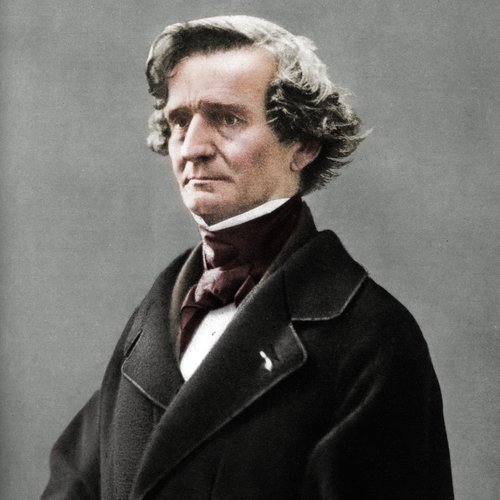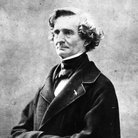Hector Berlioz: A Life
Nothing about Hector Berlioz’s music is remotely conventional. He went his own way, carving out each successive score with a bracing spontaneity and freedom that left most of his contemporaries in the shade. He lived life on a grand scale and wrote music to match – vital, breathing organisms that caress every moment as though it might be their last.
Glance over Berlioz’s official catalogue of 29 opuses and you will find not one note of chamber or solo instrumental music. His natural domains of expression were the orchestral hall, the opera house and even outdoors, yet many of his pieces defy easy classification.
His four symphonies embrace a programmatic dreamscape (Symphonie Fantastique), a pseudo-concerto (Harold En Italie), a pseudo-opera (Roméo Et Juliette) and a celebratory pièce d’occasion (Grande Symphonie Funèbre Et Triomphale).
Berlioz’s liturgical music, most notably the Grande Messe Des Morts (Requiem) and Te Deum, is no less flamboyant. The former requires eight pairs of rumbling timpani and four additional brass ensembles, the latter a children’s chorus of 600 symbolising “the mass of the people participating from time to time in a vast sacred concert.” His two major choral works – La Damnation De Faust and L’enfance Du Christ – possess a theatrical thrust more redolent of the opera stage than the concert hall.
The unprecedented scale of Berlioz’s vision influenced both his creative thinking and his performing. He conducted two blockbuster Paris concerts; the first, in 1844, totalled 1022 performers including 36 double basses for Beethoven’s Symphony No.5, 24 French horns for Weber’s Der Freischütz overture, and a staggering 25 harps in Rossini’s Prayer Of Moses.
But even this was dwarfed by an 1855 spectacular featuring a basic ensemble of 1200 instrumentalists, plus several additional choirs, brass ensembles and five sub-conductors.
The bracing freedom of Berlioz’s musical thinking also had a profound impact on the way he constructed each score. As early as the Symphonie Fantastique, he toyed with listeners’ expectations. Highly contrasted ideas collide with one another and tussle for supremacy without the slightest regard for conservatoire etiquette.
Such graphic moments as a decapitated head bouncing into a basket and an orgy of skeletal beings in full debauched flow are depicted with abandoned relish. The melody designed to symbolise his “ideal woman” (actress Harriet Smithson) throughout the symphony is more stream of musical consciousness than singable tune. In some passages, especially towards the end of the finale, the rapid changes of harmony destroy any discernible sense of key.
The quick-fire changeability of Berlioz’s music was a natural extension of his own personality. His friend Ferdinand Hiller’s description of the extreme changes in his facial features – “the glance one moment flashing, actually burning, and the next moment dull, lustreless, almost dying” – could just as well be describing one of his pioneering masterworks.
As Schumann said, “Berlioz doesn’t try to be elegant. What he hates he grasps fiercely by the hair; what he loves he almost crushes in his fervour.” The unpredictability of Berlioz’s creative temperament extended to his day-to-day life. Although he was a musical child, he was not a composing or instrumental prodigy in the Mendelssohn mould.
In any case his doctor father had him earmarked to continue in the family profession and had no intention of allowing his son to follow his artistic instincts. Meanwhile, Berlioz kept his musical aspirations alive by studying assiduously while kowtowing to his father’s wishes. In 1821 he travelled to Paris and signed up to study medicine, but after five years of painful drudgery his father relented and reluctantly gave Berlioz the green light to study music.
Things now began moving at a ferocious pace. In 1826 the 23-year old enrolled at the Paris Conservatoire, where his unconventional style raised a few eyebrows.
The following year he saw the Irish actress Harriet Smithson in a production of Shakespeare’s Hamlet and fell hopelessly and idealistically in love with her. For three years he tried unsuccessfully to put her out of his mind while he attempted to win the Conservatoire’s most prestigious annual prize – the Prix de Rome. He succeeded at the fourth attempt in 1830, the same year his churning emotions boiled over in a blazing masterpiece that put him on the musical map once and for all: the Symphonie Fantastique.
The soap opera of Berlioz’s early life continued in Rome when he discovered that a girl he had swiftly become engaged to in Paris was now betrothed to another man. Instead of accepting the situation he decided, like a character from one of the Romantic novels he found so intoxicating, to arm himself with a pair of pistols and disguise himself as a lady’s maid in order to murder his ex-fiancée. Fortunately he mislaid his outfit in Genoa and returned to the “eternal city” with his tail between his legs.
He crossed paths with Smithson again when he returned to Paris in 1832, and this time they married the following year. As reality inevitably failed to live up to Berlioz’s pre-marital fantasies, their relationship became increasingly strained, and by the time of her death in 1853 they were living apart and he was cohabiting with an old flame.
If by the time of her death Smithson was a largely forgotten figure, Berlioz had established a reputation as a renegade genius among his composing peers, including the two most prominent members of the “new music’”group, Liszt and Wagner, and the fast emerging Russian Nationalist school.
For 20 years, Berlioz’s creative flame had burned with a blazing incandescence via a remarkable series of symphonies, concert overtures, choral settings and songs that are amongst the most treasured masterworks of the Romantic era.
Yet during his lifetime and despite his success as a touring virtuoso conductor, Berlioz’s music had failed to win a significant public and critical following. With 16 years of life still remaining, he became an increasingly embittered figure, resentful at what he felt was a lack of creative recognition.
His frustration was palpable in his attempt to pass off the central section of his sacred trilogy L’enfance Du Christ (completed in 1854) as the work of a fictitious 17th century composer, “Pierre Ducré”. To his cynical delight several “expert” members of the audience were decieved by his scam, and sang Ducré’s praises.
As if to rub salt into his wounds, Berlioz’s magnum opus, the opera Les Troyens, which was intended as a grand summation of his career, largely fell on deaf ears and was never performed complete during his lifetime.
His final masterpiece, the enchanting opera Béatrice Et Bénédict (premiered in 1862), was warmly welcomed, but it was sadly a case of too little too late. Resigning from the Journal Des Débats and rapidly losing the will to compose, he turned in on himself as never before.
“My contempt for the folly and baseness of mankind, my hatred of its atrocious cruelty, have never been so intense,” he confided to his diary in 1864.
“And I say hourly to Death: ‘When you will.’ Why does he delay?” But it would be another five years before, wracked with pain from an intestinal disorder, he passed away; cruelly ignored but not forgotten.









